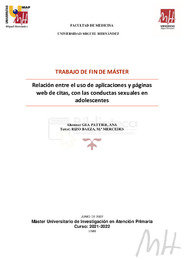Por favor, use este identificador para citar o enlazar este ítem:
https://hdl.handle.net/11000/27583Relación entre el uso de aplicaciones y páginas web de citas, con las conductas sexuales en adolescentes
| Título : Relación entre el uso de aplicaciones y páginas web de citas, con las conductas sexuales en adolescentes |
| Autor : Gea Pattier, Ana |
| Tutor: Rizo Baeza, María Mercedes |
| Editor : Universidad Miguel Hernández de Elche |
| Departamento: Departamentos de la UMH::Medicina Clínica |
| Fecha de publicación: 2022-06-05 |
| URI : https://hdl.handle.net/11000/27583 |
| Resumen : Introducción: En la adolescencia, las relaciones sociales adquieren gran relevancia, se produce la búsqueda de identidad, la aceptación social y del grupo de iguales. La llegada de las nuevas tecnologías ha permitido que personas de cualquier lugar del mundo se comuniquen de forma instantánea desde sus dispositivos móviles. Consecuentemente ha habido un despliegue de las redes sociales como método de comunicación habitual y global. Las aplicaciones de citas brindan la oportunidad de conocer instantáneamente a todo tipo de parejas sexuales y de diferentes orientaciones. La evidencia científica señala el uso de las aplicaciones de citas como un factor de riesgo emergente que conduce a comportamientos sexuales inadecuados, abusos sexuales y uso de drogas. Las estrategias de prevención y control se basan principalmente en la educación sanitaria, la promoción del sexo seguro, la detección de enfermedades tanto sintomáticas como asintomáticas y el estudio de contactos sexuales. Para todo ello el papel del profesional sanitario es fundamental. Objetivo: Conocer la relación entre el uso de páginas web y aplicaciones de citas y las conductas sexuales de los jóvenes de entre 15 y 24 años. Método: Estudio descriptivo correlacional y transversal que se realizará a lo largo de un año. Se recogerán datos de jóvenes, de 15 a 24 años usuarios de Centros de Salud Sexual de la ciudad de Alicante, que cumplan los criterios fijados a través de un formulario. Se llevará a cabo un análisis descriptivo de todas las variables. El nivel de confianza será del 95% con grado de significación (p) menor o igual a 0,05. El análisis de los datos se realizará mediante el paquete estadístico SPSS 22.0 para Windows (SPSS Institute, Chicago, IL, USA). Introduction: In adolescence, social relationships become very important, the search for identity takes place, and social and equal group acceptance occurs. The arrival of new technologies has allowed people from anywhere to communicate instantly/ immediately from their devices. Consequently, there has been an increase in the use of social networks as a method of usual and global communication. Dating apps provide the opportunity to instantly meet all kinds of sexual partners and from different orientations. Scientific evidence points the use of dating apps as an emerging risk factor leading to inappropriate sexual behaviours, sexual abuse and drug use. Prevention and control strategies are mainly based on health education, the safe sex promotion, the detection of both symptomatic and asymptomatic diseases, and the study of sexual contacts. For all these reasons, the role of the health professional is essential. Objective: Knowing the relationship between the use of websites and dating applications and the sexual behaviour of young people between 15 and 24 years old. Method: This is a correlational and cross-sectional descriptive study to be carried out over a year. Data will be collected from young people, aged 15 to 24, users of Sexual Health Centers in the city of Alicante, who meet the criteria set through a form. A descriptive analysis of all variables will be carried out. The confidence level will be 95% with a degree of significance (p) less than or equal to 0.05. Data analysis will be performed using the statistical package SPSS 22.0 for Windows (SPSS Institute, Chicago, IL, USA). In adolescence, social relationships become very important, the search for identity takes place, and social and equal group acceptance occurs. The arrival of new technologies has allowed people from anywhere to communicate instantly/ immediately from their de vices. Consequently, there has been an increase in the use of social networks as a method of usual and global communication. Dating apps provide the opportunity to instantly meet all kinds of sexual partners and from different orientations. Scientific evid ence points the use of dating apps as an emerging risk factor leading to inappropriate sexual behaviours, sexual abuse and drug use. Prevention and control strategies are mainly based on health education, the safe sex promotion, the detection of both sympt omatic and asymptomatic diseases, and the study of sexual contacts. For all these reasons, the role of the health professional is essential. Objective: K now ing the relationship between the use of websites and dating applications and the sexual behaviour of young people between 15 and 24 years old. Method : This is a c orrelational and crosssectional descriptive study to be carried out over a year. Data will be collected from young people, aged 15 to 24, users of Sexual Health Centers in the city of Alicante, who meet the criteria set through a form. A descriptive analysis of all variables will be carried out. The confidence level will be 95% with a degree of significance (p) less than or equal to 0.05. Data analysis will be performed using the statistical pac kage SPSS 22.0 for Windows (SPSS Institute, Chicago, IL, USA). |
| Palabras clave/Materias: Aplicaciones móviles Enfermedades de transmisión sexual Conducta sexual Adulto joven Mobile applications Sexually transmitted diseases Sexual behaviour Young adult |
| Área de conocimiento : CDU: Ciencias aplicadas: Medicina: Patología. Medicina clínica. Oncología |
| Tipo de documento : info:eu-repo/semantics/masterThesis |
| Derechos de acceso: info:eu-repo/semantics/openAccess |
| Aparece en las colecciones: TFM - M.U en Investigación en Atención Primaria |
 La licencia se describe como: Atribución-NonComercial-NoDerivada 4.0 Internacional.
La licencia se describe como: Atribución-NonComercial-NoDerivada 4.0 Internacional.
.png)
